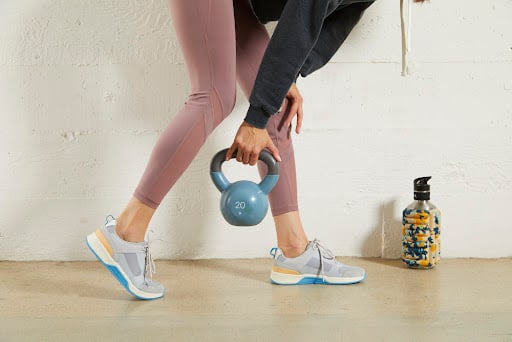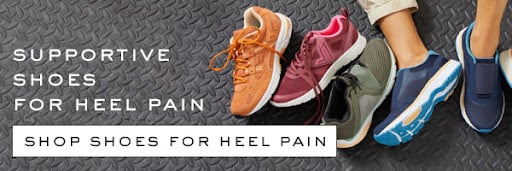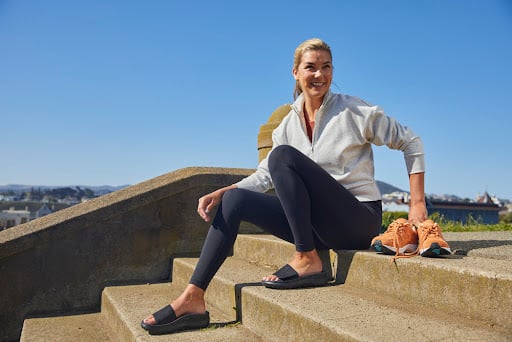Athlete’s foot is a fungal infection that starts in the toes—that’s why the shoes you wear are so important. The foot fungus that causes athlete’s foot loves damp, dark places teeming with bacteria and other germs. Depending on your shoes, you could be curating the perfect environment for athlete’s foot.
Whether you’re trying to decrease your chances of developing athlete’s foot or looking for comfortable footwear to soothe your feet while they heal, here’s everything you need to know about finding the best shoes for athlete’s foot.
#1 Material Matters
Because athlete’s foot relies on a bacteria-filled environment, you want to choose materials that reduce the likelihood of breeding those germs.
That means looking for shoes that are:
- Non-synthetic – Synthetics like plastic and rubber trap heat and moisture, which can cause or exacerbate an existing fungal infection.
- Breathable – By giving your feet space to breathe, your shoes will remain dry and, therefore, inhospitable to most bacteria. Cotton, mesh, natural leather, and canvas are all safe places to start when browsing for breathable shoes.
- Moisture-wicking – Some footwear comes with advanced technology to keep your feet dry, even when you’re sweating up a storm—or walking through one. You’ll often find this feature in the lining of work boots or high-quality sneakers like Vionic’s.
- Light – While your infection is healing, it’s important to wear shoes that aren’t too heavy. Again, it’s all about the breathability factor. Thin shoes made from mesh uppers and other lightweight fabrics increase air circulation, which can prevent damp, sweaty, fungus-prone feet.
#2 Functionally, They Have to Fit
Tight shoes and heavy shoes cause many of the same problems—they decrease air circulation, which increases how sweaty your feet are, increasing the chance of bacteria developing in your warm, damp sneakers. To prevent that, look for styles that leave plenty of wiggle room, especially for your toes. Additionally, small shoes can cause more severe problems. Read more about how to prevent blisters when running, exercising, or just during your daily routine by choosing the best running shoes for your feet.
You can find particularly roomy toe boxes in shoes with wide, square fronts. If you need extra space, look for footwear marked 2E or even 4E—these styles are especially wide for folks with feet to match.
#3 Slip Into Sandals
Which shoes have the loosest fit around the toes, guaranteed? Open-toe, of course.
They meet all the requirements of a good shoe for athlete’s foot—they let your toes breathe, keep your feet dry, and prevent the sort of damp, dark conditions that fungi like. If weather permits and you aren’t breaking any dress codes, consider letting your toes hang loose until your condition improves.
And if you’re ever in a communal shower, locker room, or on the deck of a public pool, consider wearing a pair of sandals to lower the likelihood of catching this contagious condition.
You can find plenty of sandals and slides that are still comfortable enough to walk around in and stylish enough to pair with any ensemble.
A Deep Dive Into Athlete’s Foot
Unlike some common foot ailments caused by genetics or lifestyle choices, athlete’s foot results from a contagious fungal infection. Formally known as tinea pedis, it’s a type of ringworm, of which there are several different varieties that can afflict different parts of the body.1
The ringworm fungus that leads to athlete’s foot causes a rash-like skin disorder. Usually, this rash presents along the webbed skin between the toes, though it can also infect the tops, soles, and heels of your feet, depending on the type of infection. Wherever the site of infection, the rash itself may cause:
- Itching
- Stinging
- Burning
Athlete’s foot can also cause blisters which may or may not be filled with fluid, as well as painful open sores. Athlete’s foot can also change the texture of the infected skin, causing it to become dry, cracked, or scaly. In some cases, athlete’s foot can lead to foul foot odors.
Four Ways for Athlete’s Foot to Present
Although a single type of athlete’s foot would be more than enough, there are actually a few different kinds you catch.1 They all come from the same ringworm virus, but each one affects a different area of the foot and presents unique symptoms.
Athlete’s foot can manifest in one of four unique ways:1
- Toe web infection – The most common type of athlete’s foot and the one people think of most often, this type affects the skin between your toes. Usually, it’s the skin between your fourth and fifth toes that are most at risk. Toe web type infections can cause changes in skin color and texture, including cracking and flaking.
- Moccasin infection – Somewhat like the shoe it’s named for, this type of infection covers the bottoms, edges, and heels of your feet. Most people experience sore feet for a few days before the skin becomes thick and cracked. In severe cases, this infection type can lead to toenail infections, breaking, and shedding.
- Vesicular infection – The symptoms of this type of infection include small bumps or blisters that are filled with fluid. They may appear anywhere on the bottom of the feet.
- Ulcerative infection – This is the rarest—and arguably the most unpleasant—type of athlete’s foot infection. It manifests as painful, oozing open sores on the skin along the bottom of the feet or between the toes.
Who Can Contract Athlete’s Foot?
Despite the name, you don’t have to be a medal-winning Olympian to contract athlete’s foot. Fungi don’t discriminate when they’re looking for a host. Among nature’s finest opportunists, ringworm fungi are more than happy to take up residence between anyone’s toes—if you provide the right conditions and a fostering environment, that is.
When you have athlete’s foot, it means that the ringworm fungus is living and growing on the skin of your feet. You have to come into contact with the fungus to catch it, but certain conditions can make it easier for the fungus to thrive. For example, damp, sweaty feet or socks are like welcome parties to penetrating fungi.
There are two primary ways of contracting athlete’s foot:1
- Skin-to-skin contact – Touching or rubbing against the infected skin of someone with athlete’s foot can transmit the fungus. Flakes of infected skin that have fallen off can also be contagious.
- Infected surfaces – Floors, towels, bedding, clothes—fungi love to live in damp, wet places. Unfortunately, if your skin encounters those surfaces after someone with athlete’s foot has strolled through, you could become infected.
That said, not everyone is at the same risk of infection. A person’s age, gender, health history, and lifetsyle choices can all make them more or less susceptible to athlete’s foot.
Athlete’s foot usually affects people who:1
- Are male and in their sixties
- Are diabetic or obese
- Have weakened immune systems
- Have suffered foot tissue damage or injury
Additionally, due to the transmission method, people who frequent public places where shoes are not required are more likely to catch athlete’s foot. This includes places like saunas, swimming pools, and fitness centers.
Is There a Cure For Athlete’s Foot?
The fungal infection that causes an athlete’s foot is entirely treatable.1 Generally, it involves using a variety of antifungal medications to arrest bacterial growth, kill the fungus, and heal damaged skin. These antifungal products may be either prescribed by a doctor or available over-the-counter. They usually come as:
- Creams
- Gels
- Ointments
- Sprays
- Powders
- Pills, occasionally
If you catch athlete’s foot, it’s important to seek treatment right away. Although for most people, the condition isn’t serious and is easily remedied, it can quickly escalate, spreading and growing across your body through scratching or toweling dry.
That said, with proper treatment, the infection should clear up within a couple of weeks to two months.
How To Prevent Athlete’s Foot
Because athlete’s foot is a contagious infection, you have a limited amount of control over when, where, and if you contract it.
That said, there are a few effective measures that you can take to avoid the fungus, especially if you’re at special risk of infection.2
Here are three tips for dodging athlete’s foot infections:
- Prioritize toenail hygiene – Fungus and bacteria love to squat under the protective surface of your toenails. You can make them feel less at home by keeping your toenails short and clean, with no hiding places and no reason to want to do so.
- Make your shoes inhospitable – Avoiding athlete’s foot begins with making your feet the last place fungus wants to be. That means you should keep them cool, clean, and dry. And if you tend to switch footwear at home, it wouldn’t hurt to learn how to sanitize shoes before entering the house.
- Protect your feet – If you use a public gym, pool, or sauna, resist the temptation to go barefoot, especially in the locker rooms and showers. Wearing socks is one form of protection. This makes it harder for fungus to find your feet.
Vionic: The Best Shoes for Athlete’s Foot
When you have athlete’s foot, the shoes you wear and the kind of foot care you choose become more important than ever. No longer just a fashion statement, you need to choose your shoes based on comfort, breathability, fit, and material.
At Vionic, we specialize in crafting stylish, comfortable, and supportive shoes for every foot, whether you have athlete’s foot, another condition, or perfectly healthy feet. With podiatrist-approved features that promote all-day comfort, support, and stability from heel to toe, our shoes set the bar for pleasing and pampering your feet.
With dozens of trendy styles, including casual shoes, sneakers, boots, and sandals for men and women, Vionic is where you turn for shoes that support your feet and your lifestyle. Shop Vionic today.
Sources:
- “Athlete’s Foot (Tinea Pedis)” Cleveland Clinic, 1 December, 2021. https://my.clevelandclinic.org/health/diseases/22139-athletes-foot-tinea-pedis
- “Hygiene-related diseases”. Centers for Disease Control, 6 February, 2017. https://www.cdc.gov/healthywater/hygiene/disease/athletes_foot.html




Leave a Reply